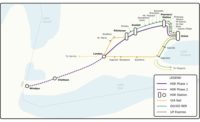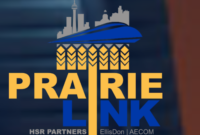A $15-billion high-speed-rail line that would be one of the most expensive infrastructure projects ever built in Canada could get a boost from the Trudeau government's proposed public-works financing bank.
If approved by parliament, the $25-billion Canada Infrastructure Bank will examine whether to help finance the proposal by Ontario for a high-speed-rail system connecting Toronto with the cities in the province's southern tier, according to a spokeswoman for Amarjeet Sohi, the minister of infrastructure and communities.
Ontario officials recently announced plans to move ahead with preliminary design work for the high-speed-rail line, which would run between Toronto and Windsor, which borders the U.S. near Detroit.
It also would be the first high-speed-rail line in Canada, which has lagged behind the United Kingdom and Germany in the development of fast trains.
Sohi, Canada's infrastructure chief, also has indicated the bank may also look at financing a proposed Edmonton-to-Calgary high-speed-rail line in western Canada.
"The proposed high-speed-rail link between Toronto and Windsor is an interesting project [that] we will examine alongside our municipal and provincial partners to see how it may fit with our programs and as a project for the Canada Infrastructure Bank," said Brook Simpson, a spokeswoman for Sohi and the infrastructure ministry.
John Gamble, president and chief executive of the Canadian Association of Consulting Engineering Companies (ACEC), believes the Ontario high-speed-rail line fits the proposed bank's mission, which is to entice pension funds and other private investors to pump money into major infrastructure projects that might not otherwise get built.
The project is also the type of economy-boosting infrastructure for which ACEC has advocated. "It fulfills that definition of hard, economic infrastructure," Gamble said.
The high-speed-rail line, which would be built out over several years, would create thousands of construction jobs, said Bill Ferreira, vice president of the Canadian Construction Association.
"Obviously, there would be a significant amount of construction jobs involved," Ferreira said. "Beyond the immediate impact, it's the economic growth this would help stimulate by connecting Toronto with other cities and shortening the travel time between them."
But Terrence Corcoran, a columnist for Canada's Financial Post, was critical of the plan. Citing transportation consultant Steer Davies Gleave's 2016 report for the Ontario Ministry of Transportation, Corcoran noted the operating-cost risks, such as rising power costs, despite the economic benefits.
He says the report's projections "make it clear that all versions of the rail scheme are guaranteed to be net-cash drains. Even after the big losses are fudged and massaged and manipulated by adding in so-called social and economic benefits, there is no financial or economic case for sinking billions into high-speed rail across [southern] Ontario."
The high-speed-rail line would cover the 206 miles between Toronto and Windsor at 150 miles per hour, stopping along the way at Guelph, Kitchener-Waterloo, London and Chatham, with a connection to Pearson International Airport.
In a first step, Ontario Premiere Kathleen Wynne has announced an $11-million environmental assessment of the project.
The proposed high-speed-rail line would be one of the largest public-private infrastructure endeavors ever undertaken in Canada, with most P3 projects typically in the $260-million to $300-million range, Gamble said.
"In terms of the order of magnitude, this is a major undertaking," he said.
Recruiting investors may not necessarily be a slam dunk. Typically, pension funds would prefer to put money into infrastructure that has been built and has a proven track record of spinning off revenue.
Jim Leech, former chief executive of one of Canada's largest public pension funds and now a special adviser to the proposed infrastructure bank, acknowledged the challenge but insisted it can be met.
"That is the whole rationale for the bank—to bridge the gap by redistributing the risk and reward to make a greenfield project interesting for an institution," he wrote in an email.
The proposed infrastructure bank is now being debated in parliament, with some critics questioning its need, arguing the federal government can borrow at lower rates now than the private sector can.
Still, given that the Trudeau government now controls parliament, the main question is not whether the proposed bank will pass but, rather, what concessions will be made.
Industry officials hope the bank has the independence to pick which projects to fund, rather than having Ottawa select them.
While the federal government will pick the bank's leader, Gamble says he or she should have the ability to operate the bank without micromanagement or interference.
"It would be a disincentive for investors if the cabinet is picking projects," he said. "At some point, the government is going to have to take its hands off the steering wheel."





Post a comment to this article
Report Abusive Comment